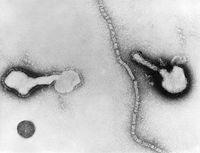Parainfluenza virus
| Human Parainfluenza Virus | ||
|---|---|---|
 | ||
| Virus classification | ||
|
Description and significance
Parainfluenza refers to a group of viruses that cause upper and lower respiratory infections. Human parainfluenza viruses (HPIVs) are paramyxoviruses and are second to respiratory syncytial virus (RSV) as a most common cause of upper and lower respiratory tract infections especially in infants and young children [1]. It is less common in adults. Paramyxoviruses are viruses of the Paramyxoviridae family of the Mononegavirales order; they are negative-sense single-stranded RNA (-ssRNA) viruses responsible for a number of human and animal diseases. Negative-sense ssRNA viruses must have their genome copied by an RNA polymerase to form positive-sense RNA. This means that the virus must bring along with it the RNA-dependent RNA polymerase enzyme. The positive-sense RNA molecule then acts as viral mRNA, which is translated into proteins by the host ribosomes. The resultant protein goes on to direct the synthesis of new virions, such as capsid proteins and RNA replicase, which is used to produce new negative-sense RNA molecules.
Genome structure
Cell structure and metabolism
Ecology
Pathology
Application to Biotechnology
Current Research
References
Be sure to replace "Needs" in "Needs Workgroup" below with a workgroup name. See the "Workgroups" link on the left for a list of workgroups.